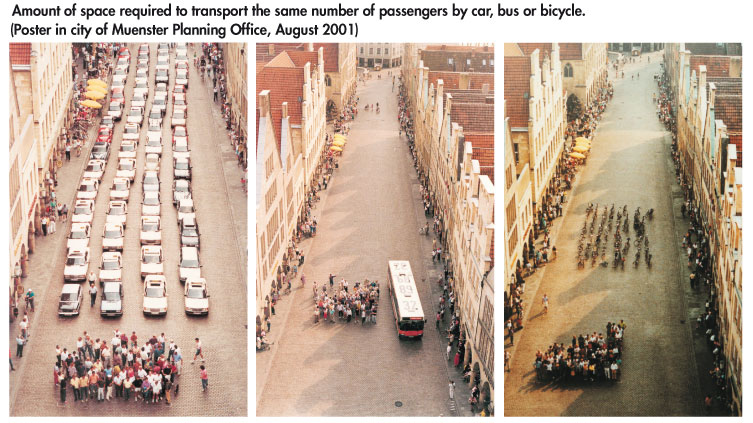I went to Copenhagen for 4 months to discover why people there are so happy, since Denmark is continuously ranked one of the happiest nations in the world. I want to share with you a bit of that happiness , and convince you how it can be done in Boston. The most important secret I learned is this: design for human connection.
This is different from the way United States design cities. In the United States, cities have been designed around cars, not humans. In 1909, the First National Conference on City Planning was held in Washington, DC. The vision developed there was an urban freeway to promote transportation all across the United States. This set the tone for the years ahead. The rise of automobiles led to the destruction of neighborhoods caused by new highways, creation of suburbs, and design of downtowns to accommodate parking. Since then, cities are marked by bustling highways, honking traffic, and gray pavement.
A car’s function is to get from A to B, rather than experiencing the space between A and B. When metallic monstrosities on the streets soar past one another, they never stop to exchange conversation. There are no faces, simply tinted glass shields. Cities dominated by cars are impersonal. Seeing people and forming connections is the initial stage to engage in a community. Therefore, cities’ infrastructure need to be characterized by humans not cars.
The best action to improve human connection is to stop driving, yet that is hard to do without help. Here are some action and app suggestions for embracing alternative transportation to that can enrich human engagement:
- Get Collaborative and Carpool
Copenhagen has a 200% tax on cars, which incentives people to stop buying cars. They learned that the fastest way to humanize cities is to drive less. Sharing a ride is an alternative. It can decrease congestion in the city, and all it requires is a little planning! Apps like uberPOOL, Lyft, Sidecar, and Coride.com are all useful apps targeted to Boston. To really make a long-lasting difference, make this a habit and become a carpool commuter.
Carpooling can also reduce traffic. If everyone carpooled just one day a week, the traffic on highways and roads in the United States would be reduced up to 20%. A reduction in traffic is a reduction of your time spent in a metal box, as well as the money flying out of your wallet. An average carpooler can save up to $600 each month spent on gas, tolls, parking, and maintenance. Calculate your savings here.
- Get Friendly With Public Transportation
Public transport is another way to connect with the people around you in a less direct way. The act of sharing a public space, recognizing common faces, and acknowledging each other’s presence builds community.
Similar to Copenhagen, Boston has various modes of public transportation that can get hard to memorize. OpenMBTA is a free app that gives real-time Boston MBTA schedules. Nextime provides notifications and alerts, and Nexmap shows the bus, rail, and train routes at every stop.

Energy Comparison for Various Modes of Transport. Source: https://www.exploratorium.edu/cycling/humanpower1.html
- Get Personal and Show Your Face
50% of the population in Copenhagen commute by bike every day all year round, even in the snow. Bikes are wonderful for revealing human faces. A study from students at Columbia University found that the average single-trip distance in a car for a U.S. citizen is 5.95 miles–the perfect distance for a bike ride! RideScout is an app that provides real-time transportation routes. Use this app to get comfortable with riding your bike around the city. Safety is extremely important, so Boston University designed an app, BU Bike Accident Toolkit, to educate people on bike safety, as well as document accidents.
There are numerous other reasons bikes are beneficial. To begin with, biking is the most energy efficient mode of transportation. Driving a car uses 80 times as much energy in comparison to biking. Second, evolutionary, bikes better fit for our senses than cars. Jan Gehl, a Danish urban designer, argues that humans have evolved to experience the world at 3 miles per hour, aka our walking pace. So, cars going at 30 kilometers per hour blurs our senses, and only something of great length is a little bit exciting. Riding your bike does the opposite. When you bike, you can smell the coffee from the cafe, hear the wind whistle through the leaves, and see the faces of every individual you pass. Biking places you in the environment, tingles your senses, and creates a level of intimacy between you and others on the street. Biking brings the city down to the human scale and forces you to be present.
People love seeing people, just look at all the people at the Boston Common. Hopefully these three tips, with or without the smartphone apps, will make your social experience in a city more valuable. In the words of Jan Gehl, “A good city is like a good party. People don’t want to leave early.”And good parties are the ones with a lot of happy people.
